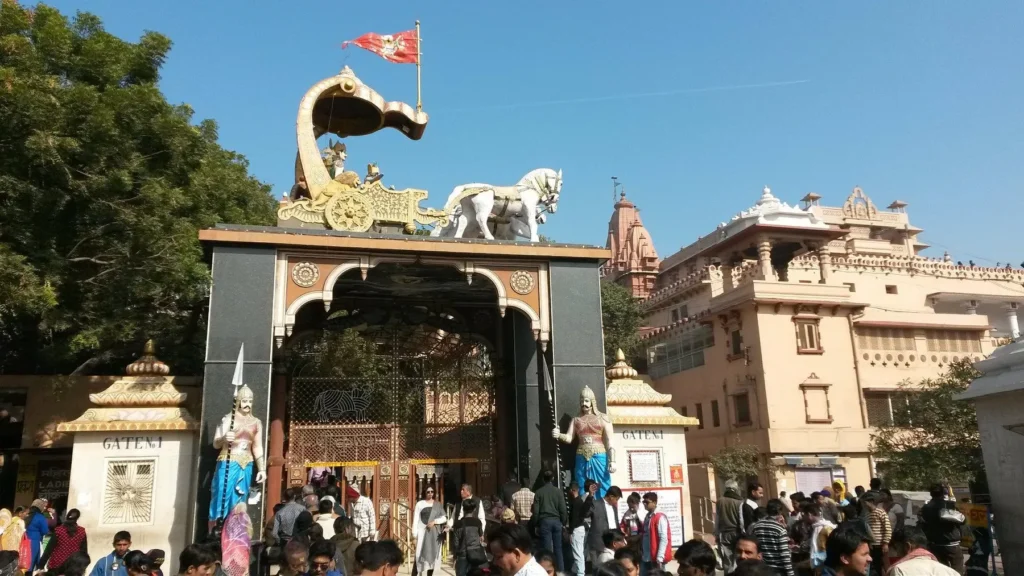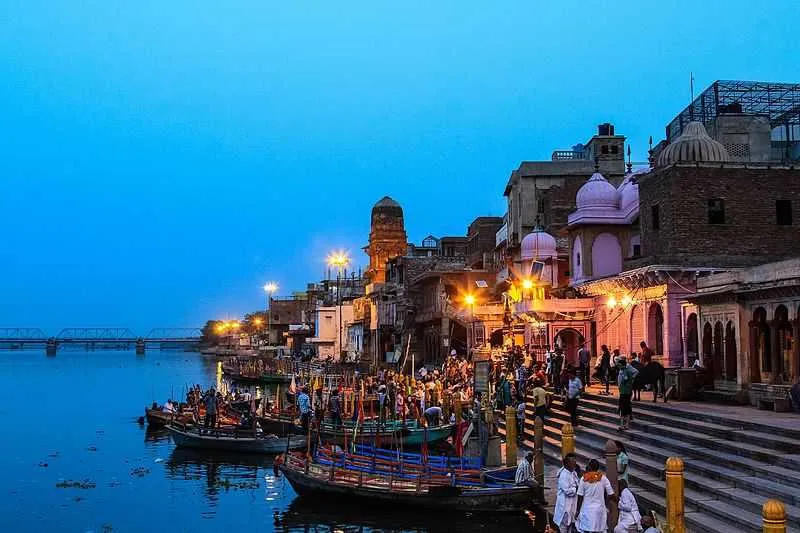Places And Temples to visit in Mathura

Mathura, one of the oldest and holiest cities in India, is known as the birthplace of Lord Krishna, the 8th avatar of Lord Vishnu. Located on the banks of the Yamuna River, this sacred city is filled with countless temples, attracting pilgrims, tourists, and history lovers from all over.
The riverbank is lined with 25 ghats, best visited at sunrise for the holy dip or at sunset, when lamps and candles float on the water during evening prayers. With its deep connection to Krishna’s life and many ancient temples, Mathura remains a spiritual center for millions of devotees.
Here are some of the must-visit temples in Mathura:
Shri Krishna Janmabhumi -

Among all the temples in Mathura, the Krishna Janmabhoomi Temple is the most important for devotees. It is built on the exact spot where Lord Krishna was born. Archaeological findings show that there used to be a prison here.
According to the story, Devaki and her husband Vasudev were kept imprisoned by King Kansa, Devaki’s brother. Kansa had been warned that he would be killed by their eighth child. When Krishna was born, all the prison doors opened on their own, and the guards became unconscious, allowing Vasudev to safely take baby Krishna to Nandgaon.
Every year on Janmashtami, millions of pilgrims visit this temple to celebrate Krishna’s birth. The temple stands over the room believed to be the prison where Krishna was born more than 3,500 years ago. It is the most sacred Hindu temple for Krishna devotees.
Keshavdev Temple –

Keshav Dev Temple is an old temple located near the main Krishna Janmabhoomi complex, the birthplace of Lord Krishna. Keshav Dev is one of the many names of Lord Krishna and is the main deity of this temple.
A newer Keshav Dev temple was recently built inside the Krishna Janmabhoomi area, which has overshadowed the old temple. It is believed that the nearby Idgah Mosque was once the site of the original Keshav Dev Temple. In 1669, during Muslim rule, Aurangzeb destroyed the temple and later built the mosque in its place.
Dwarkadhish Mandir –

Dwarkadheesh Temple in Mathura is a well-known temple dedicated to Lord Krishna, built in 1814 by Seth Gokul Das Parikh, the treasurer of the Gwalior Estate. It is located close to the Yamuna River near Vishram Ghat. The temple gets its name because Krishna is also called the “King of Dwarka.” Inside, the walls are beautifully decorated with paintings and carvings that tell the stories of Krishna’s life and pastimes.
This temple is a popular place for devotees and tourists, especially during important festivals like Janmashtami, Holi, and Diwali when it is beautifully decorated and filled with celebrations. Dwarkadheesh Temple remains an important spiritual and cultural spot in Mathura for people who come to seek blessings and experience Krishna’s divine stories.
Gita Temple (Birla Mandir) –

Gita Mandir in Mathura was built by Jugal Kishore Birla of the Birla Group in memory of his parents. The temple is famous for its 18 pillars, each representing a chapter of the Bhagavad Gita. Located about 5 km from Mathura city on the way to Vrindavan, the temple beautifully blends Hindu culture, art, and tradition with a touch of modern design.
Made from red sandstone and peaceful white marble, the temple is a stunning example of craftsmanship. The entire Bhagavad Gita is carved on the walls, making it a special place for visitors and devotees alike.
Vishram Ghat -

Vishram Ghat is home to many important temples in Mathura, including Mukut Temple, Radha-Damodar, Murli Manohar, and more. It is also near the baithak of the great Vaishnava saint Shri Chaitanya.
The nightly aarti here is a must-see, with oil lamps floating on the Yamuna River, lighting up the water beautifully.
Historically, Vishram Ghat was damaged during early invasions but was restored by saints like Keshav Kashmiri and Vallabhacharya. It later received support during Akbar’s reign.
This ghat is special because, according to legend, Lord Krishna rested here after defeating the evil King Kansa. It is also the start and end point of the traditional Yamuna parikrama (circumambulation).
